Tolworth Hospital
Red Lion Road, Surbiton, Surrey KT6 7QT
Medical
dates:
Medical
character:
Isolation. Later, geriatric, then mental.
The Infectious Diseases
(Prevention) Act, 1889, compelled local authorities to isolate
infectious patients to prevent the spread of disease.
The Kingston Rural Sanitary Authority proposed to purchase a plot of land in Red Lion Lane on which to build an isolation hospital. The plan was fiercely opposed at two public meetings on the grounds that the land was a swamp and therefore unsuitable. Nearby residents feared that an isolation hospital would devalue their properties, while concern was expressed for the cattle in the area and the many children who lived in the Lane.
However the Rural Sanitary Authority prevailed. It purchased the 1 hectare site and work began on the building.
The Tolworth Isolation Hospital opened in 1889 with 22 beds.
In 1906 the Hospital was extended. A 12-bedded cubicle block was built, the second of its type in the country. The Hospital then had 40 beds.
In 1925, 1932 and 1935 adjacent land was purchased, increasing the size of the plot to 9 acres (3.6 hectares). More buildings were added, so that patients with scarlet fever, enteric fever or diphtheria could be better isolated. These included an isolation block with 10 cubicle beds and one with 20 pavilion beds, additional administrative buildings and a Nurses' Home.
The newest blocks were opened on 27th July 1935 by Alderman J. Chuter, Chairman of Surrey County Council. The new wards contained 10 beds each and were entirely lit by three ceiling pendant lights 9 ft 9 in (3 metres) from the floor. Beside each bed was a power socket for the doctor's lamp and a wireless (radio). The Hospital then had 110 beds.
During WW2 the Hospital suffered damage from two high explosive bombs on 17th November 1940. One fell on the driveway and one on a ward. Amazingly, only two people were slightly injured, but the ward was damaged beyond repair.
In 1948 the Hospital joined the NHS under the control of the Kingston Group Hospital Management Committee, part of the South West Metropolitan Regional Health Board. By this time it had been more or less abandoned because of the lack of patients - of its 112 beds, only about 12 were open.
The Hospital Management Committee gradually redeveloped the site, but two blocks were too badly damaged to be reopened so were pulled down. The Hospital then had 92 beds.
By 1955 it had 104 beds - 18 for the chronically sick, 18 for infectious diseases patients, 24 for children (in cubicles of 2 cots each) and 44 for TB patients.
The chronic wards were old-fashioned with no bedpan washer, but half the patients were wheeled to the WC or used a sanitary chair. The other half were incontinent, so there was no need for them to use bedpans.
The children's wards, built in 1910, had their wash basins, WCs and bathrooms outside the wards in the open air. These were all glazed with a verandah, so that the sanitary fittings were no longer outside.
The TB section was divided into male and female wards. The male ward had a Day Room and a solarium on the roof.
By 1960 the Hospital had 104 beds for paediatric, chest and geriatric patients.
It was planned that work to rebuild part of the Hospital would begin in 1965, but the start was delayed until the late 1960s. Many of the old buildings were demolished and the new modern geriatric wards were officially opened by Princess Alexandra in February 1969.
In 1974, following a major reorganisation of the NHS, the Hospital came under the control of the Kingston and Richmond District Health Authority, part of the South West Thames Regional Health Authority. It had 168 beds for paediatric and geriatric cases.
In 1982, after another major reorganisation of the NHS, the Hospital came under the administration of the Kingston and Esher District Health Authority.
By 1989 it had 127 beds for geriatric patients only.
In 1992, when Long Grove Hospital closed, its remaining patients were transferred to a smaller unit at the Hospital.
In 1994, following the introduction of the 'requisitioner-provider' system in the NHS, the Hospital came under the management of the Kingston and District Community NHS Trust. It had 189 beds for Care of the Elderly.
In 2004 the Hospital transferred to the administration of the South West London and St George's Mental Health NHS Trust.
The Kingston Rural Sanitary Authority proposed to purchase a plot of land in Red Lion Lane on which to build an isolation hospital. The plan was fiercely opposed at two public meetings on the grounds that the land was a swamp and therefore unsuitable. Nearby residents feared that an isolation hospital would devalue their properties, while concern was expressed for the cattle in the area and the many children who lived in the Lane.
However the Rural Sanitary Authority prevailed. It purchased the 1 hectare site and work began on the building.
The Tolworth Isolation Hospital opened in 1889 with 22 beds.
In 1906 the Hospital was extended. A 12-bedded cubicle block was built, the second of its type in the country. The Hospital then had 40 beds.
In 1925, 1932 and 1935 adjacent land was purchased, increasing the size of the plot to 9 acres (3.6 hectares). More buildings were added, so that patients with scarlet fever, enteric fever or diphtheria could be better isolated. These included an isolation block with 10 cubicle beds and one with 20 pavilion beds, additional administrative buildings and a Nurses' Home.
The newest blocks were opened on 27th July 1935 by Alderman J. Chuter, Chairman of Surrey County Council. The new wards contained 10 beds each and were entirely lit by three ceiling pendant lights 9 ft 9 in (3 metres) from the floor. Beside each bed was a power socket for the doctor's lamp and a wireless (radio). The Hospital then had 110 beds.
During WW2 the Hospital suffered damage from two high explosive bombs on 17th November 1940. One fell on the driveway and one on a ward. Amazingly, only two people were slightly injured, but the ward was damaged beyond repair.
In 1948 the Hospital joined the NHS under the control of the Kingston Group Hospital Management Committee, part of the South West Metropolitan Regional Health Board. By this time it had been more or less abandoned because of the lack of patients - of its 112 beds, only about 12 were open.
The Hospital Management Committee gradually redeveloped the site, but two blocks were too badly damaged to be reopened so were pulled down. The Hospital then had 92 beds.
By 1955 it had 104 beds - 18 for the chronically sick, 18 for infectious diseases patients, 24 for children (in cubicles of 2 cots each) and 44 for TB patients.
The chronic wards were old-fashioned with no bedpan washer, but half the patients were wheeled to the WC or used a sanitary chair. The other half were incontinent, so there was no need for them to use bedpans.
The children's wards, built in 1910, had their wash basins, WCs and bathrooms outside the wards in the open air. These were all glazed with a verandah, so that the sanitary fittings were no longer outside.
The TB section was divided into male and female wards. The male ward had a Day Room and a solarium on the roof.
By 1960 the Hospital had 104 beds for paediatric, chest and geriatric patients.
It was planned that work to rebuild part of the Hospital would begin in 1965, but the start was delayed until the late 1960s. Many of the old buildings were demolished and the new modern geriatric wards were officially opened by Princess Alexandra in February 1969.
In 1974, following a major reorganisation of the NHS, the Hospital came under the control of the Kingston and Richmond District Health Authority, part of the South West Thames Regional Health Authority. It had 168 beds for paediatric and geriatric cases.
In 1982, after another major reorganisation of the NHS, the Hospital came under the administration of the Kingston and Esher District Health Authority.
By 1989 it had 127 beds for geriatric patients only.
In 1992, when Long Grove Hospital closed, its remaining patients were transferred to a smaller unit at the Hospital.
In 1994, following the introduction of the 'requisitioner-provider' system in the NHS, the Hospital came under the management of the Kingston and District Community NHS Trust. It had 189 beds for Care of the Elderly.
In 2004 the Hospital transferred to the administration of the South West London and St George's Mental Health NHS Trust.
Present status (June 2008)
The Hospital is still operational and very active.
UPDATE: October 2015
In 2014 none of the wards were considered to be fully compliant with modern standards and the Trust decided to redevelop the 3.3 hectare site.
Woodroffe House and the Acacia and Jasmine Units will remain, while the 1960s buildings will be demolished.
Six new wards will be built, as well as administration and out-patient buildings, at a cost of £60m. If the project is approved, work will begin in late 2017 at the earliest.
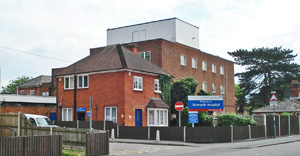
The northern entrance lane beside the old gatehouse, now the Stores Department.

The southern entrance.
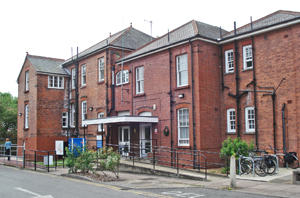
Woodroffe House has been extended variously over the years.
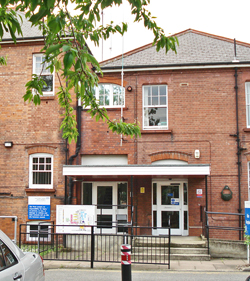
The main entrance.

Perhaps the original part of Woodroffe House.
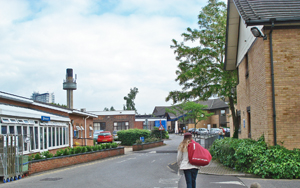
Newer buildings behind Woodroffe House - the restaurant on the left and Draycott House on the right. More blocks can be been at the rear of the site.
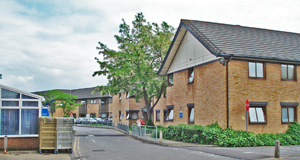
Draycott House.
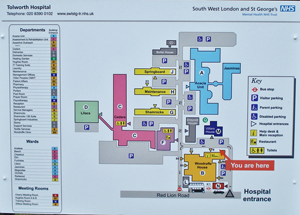
A schematic site map of the Hospital (above) - Red Lion Road is shown at the bottom - and a local street plan (below) showing the layout and extent of the Hospital buildings (in purple).

(Author unstated) 1936 Hospital lighting. British Medical Journal 1 (3924), 590-591.
(Author unstated) 1965 Postponed hospital building projects. British Medical Journal 1 (5450), 1618.
(Author unstated) 2014 Fever, filth and fear. Public Health and the History of Medicine in Kingston upon Thames. Kingston Museum.
Barnes T 2012 Fears over 'privatisation' of Tolworth Hospital dementia ward. Surrey Comet.
Dewji N 2014 Plans for Tolworth Hospital to undergo £60m redevelopment. Your Local Guardian.
Lindsell D 2009 Tolworth staff attacked once every five days. Your Local Guardian.
Lindsell D 2011 'Dangerous patient' ward moved from Toldworth Hospital. Your Local Guardian.
Lindsell D 2012 Anger at threat to Tolworth Hospital beds. Your Local Guardian.
Sharman J 2013 Tolworth Hospital trust pays out £700,000 to staff to leave early. Your Local Guardian.
Sharman J 2015 Two-thirds back £160m mental health revamp to centralise services in Tolworth and Springfield hospitals, but fears raised over transport. Your Local Guardian.
http://hidden-london.com
www.flickr.com
www.johnsonltd.co.uk
www.merton.gov.uk (1)
www.merton.gov.uk (2)
www.swlstg-tr-nhs.uk (1)
www.swlstg-tr.nhs.uk (2)
www.yourlocalguardian.co.uk
www6.kingston.gov.uk (1)
www6.kingston.gov.uk (2)
www6.kingston.gov.uk (3)
Return to home page